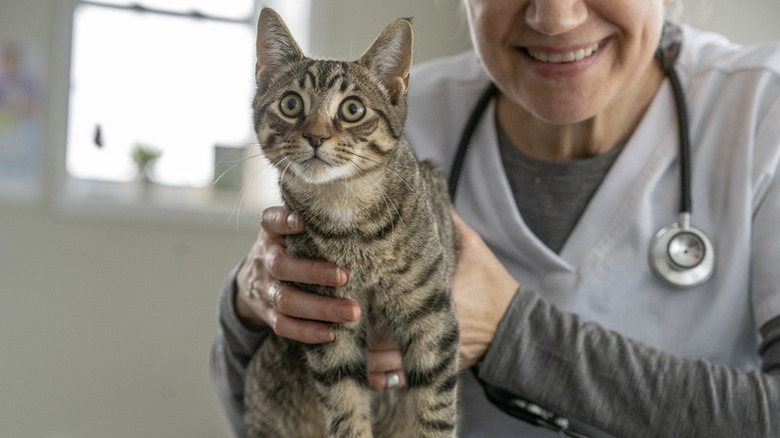Synulox For Cats: Side Effects And Uses
Synulox is a prescription antibiotic in the penicillin family that is useful in treating a variety of bacterial infections in cats, from respiratory tract and urinary tract infections to skin disease. Side effects are typically mild and uncommon.
What is Synulox for cats?
Synulox is one of the most common antibiotics prescribed for cats. Synulox is marketed under the brand name Clavamox in the U.S. and is manufactured by Zoetis. The medication is a combination of the active ingredients amoxicillin trihydrate and clavulanate potassium. The clavulanic acid helps amoxicillin fight bacteria that's normally resistant to penicillin-type medications. These drugs can penetrate most bodily tissues and fluids in a cat except spinal fluid and the brain.
Howdoes Synuloxfor cats work?
Synulox is similar to penicillin in fighting bacterial infection. The clavulanic acid added to the amoxicillin protects the antibiotic from enzymes that may destroy the amoxicillin before it can kill the bacteria. The antibiotic is not effective against viral infections.
Synulox for cats: uses
Synulox is an effective treatment for a variety of infections in cats, such as:
- Urinary tract infections
- Skin disease (e.g. pyoderma) and infected wounds such as abscesses
- Soft tissue infections
- Respiratory disease due to infection
- Dental infections (or gingivitis)
Bacteria killer
Synulox inhibits beta-lactamase that bacteria can produce to resist antibiotics. Therefore, it effectively treats infections of a variety of gram-positive and gram-negative bacteria, including:
- E. coli
- Pasteurella spp.
- Staphylococcus aureus
- Staphylococcus spp.
- Streptococci spp.
- Certain Proteus species
- Klebsiella pneumoniae
Synulox for cats side effects
Synulox is considered quite safe, and most cats tolerate it well. Potential side effects are usually mild and short-lived. These possible side effects include:
- Vomiting and nausea: Nausea could be alleviated by administering the medication with food.
- Diarrhea: The antibiotic can interfere with the healthy bacteria in the gut, which can cause diarrhea. If your cat develops mild diarrhea, your veterinarian may recommend a probiotic.
- Loss of appetite: If your cat stops eating, consult your veterinarian right away. A serious secondary liver condition (hepatic lipidosis) can result from even just a couple days of decreased appetite.
If stomach upset persists, contact your veterinarian before discontinuing treatment. Effectively curing the infection being treated may warrant tolerating mild side effects.
How is Synulox given to cats?
Synulox is available in tablet form as well as oral suspension (liquid form). You and your veterinarian can discuss which form is likely easiest to administer to your cat. The tablets come in both chewable and nonchewable form. If using the chewable form, it's a good idea to hide the tablet in a pill pocket or tasty food. If your cat is especially picky, you might have to administer the tablet or liquid directly into their mouth.Make sure they have a little food in their stomach first
Synulox palatable tablets come in sealed blister packs and should be stored in a cool, dry place. Avoid getting out a tablet until you're ready to administer it. The liquid form usually needs to be refrigerated. Shake well before use. Liquid Clavamox should be discarded after 10 days.
If you miss a dose, administer it as soon as you remember. However, if it's almost time for the next dose, just skip the missed dose and continue with the schedule. Do not give two doses at one time. If your cat doesn't tolerate being medicated by the oral route, your veterinarian may be able to administer an antibiotic injection that lasts for 7 days.
Howlong does it take Synulox towork in cats?
The medication will start working within one to two hours, though you may not see symptoms of infection abate for a couple of days. As with all antibiotics, it's important to administer the full course of antibiotics prescribed by your veterinarian, even after you see improvements in your cat's health.
According to Vet Pet World, the standard dosage rate 12.5 mg/kg bodyweight. The dosing and length of the course of treatment will depend on the infection, but your cat will typically take Synulox for at least seven days.
Other warnings and contraindications for Synulox
Pregnant or lactating cats should not take Clavamox. Allergic reactions to Synulox are rare. If you know your cat is allergic to penicillin, Clavamox should not be administered. Be sure to tell your veterinarian about any other medications or supplements your cat is on. If you see any of these signs of an allergic reaction, which can result in abnormal red and white blood cell counts, contact your veterinarian immediately:
- Hives
- Rashes
- Fever
The drug is not appropriate for small herbivores, such as rabbits, guinea pigs, and hamsters, because it can cause severe enteritis or gastrointestinal issues, which may lead to death.
If you or anyone in your family is allergic to penicillin, avoid exposure to this drug. If necessary, wear disposable gloves while administering the pills or liquid medication and wash your hands thoroughly afterward.
The bottom line
While Synulox is similar to penicillin, it's a unique antibiotic because it contains clavulanate acid in addition to amoxicillin. This ingredient helps to make it even more effective against certain types of bacterial infections. In veterinary medicine, Synulox is considered very safe to use in cats. Any stomach upset or side effect is typically mild and dissipates quickly.

